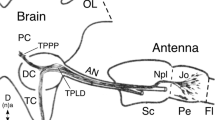Abstract
Three flexor muscles of the posterior tentacles of the snail Helix pomatia have recently been described. Here, we identify their local motor neurons by following the retrograde transport of neurobiotin injected into these muscles. The mostly unipolar motor neurons (15–35 µm) are confined to the tentacle digits and send motor axons to the M2 and M3 muscles. Electron microscopy revealed small dark neurons (5–7 µm diameter) and light neurons with 12–18 (T1 type) and 18–30 µm diameters (T2 type) in the digits. The diameters of the neurobiotin-labeled neurons corresponded to the T1 type light neurons. The neuronal processes of T1 type motor neurons arborize extensively in the neuropil area of the digits and receive synaptic inputs from local neuronal elements involved in peripheral olfactory information processing. These findings support the existence of a peripheral stimulus–response pathway, consisting of olfactory stimulus—local motor neuron—motor response components, to generate local lateral movements of the tentacle tip (“quiver”). In addition, physiological results showed that each flexor muscle receives distinct central motor commands via different peritentacular nerves and common central motor commands via tentacle digits, respectively. The distal axonal segments of the common pathway can receive inputs from local interneurons in the digits modulating the motor axon activity peripherally without soma excitation. These elements constitute a local microcircuit consisting of olfactory stimulus—distal segments of central motor axons—motor response components, to induce patterned contraction movements of the tentacle. The two local microcircuits described above provide a comprehensive neuroanatomical basis of tentacle movements without the involvement of the CNS.









Similar content being viewed by others
References
Chase R (2002) Behavior and its neural control in gastropod molluscs. Oxford University Press, Oxford
Chase R, Croll RP (1981) Tentacular function in snail olfactory orientation. J Comp Physiol 143:357–362
Chase R, Tolloczko B (1986) Synaptic glomeruli in the olfactory system of a snail, Achatina fulica. Cell Tissue Res 246:567–573
Chase R, Tolloczko B (1993) Tracing neural pathways in snail olfaction: from the tip of the tentacles to the brain and beyond. Microsc Res Tech 24:214–230
Croll RP, Chase R (1980) Plasticity of olfactory orientation to foods in the snail Achatina fulica. J Comp Physiol A 136:267–277
Friedrich A, Teyke T (1998) Identification of stimuli and input pathways mediating food-attraction conditioning in the snail, Helix. J Comp Physiol A 183:247–254
Hernádi L, Teyke T (2012) A novel triplet of muscles with flexor function in the posterior tentacles of the snail Helix pomatia. Acta Biol Hung 63(Suppl 2):123–128
Hernádi L, Teyke T (2013) Neuronal background of positioning of the posterior tentacles in the snail, Helix pomatia. Cell Tissue Res 352:217–225
Krajcs N, Mark L, Elekes K, Kiss T (2012) Morphology, ultrastructure and contractile properties of muscles responsible for superior tentacle movements of the snail. Acta Biol Hung 63(Suppl 2):129–140
Lemaire M, Chase R (1998) Twitching and quivering of the tentacles during snail olfactory orientation. J Comp Physiol 182 A:81–87
Nikitin ES, Zakharov IS, Samarova EI, Kemenes G, Balaban PM (2005) Fine tuning of olfactory orientation behaviour by the interaction of oscillatory and single neuronal activity. Eur J Neurosci 22:2833–2844
Nikitin ES, Korshunova TA, Zakharov IS, Balaban PM (2008) Olfactory experience modifies the effect of odor on feeding behavior in a goal-related manner. J Comp Physiol A 194:19–26
Peschel M, Straub V, Teyke T (1996) Consequences of food-attraction conditioning in Helix: a behavioral and electrophysiological study. J Comp Physiol A 178:317–327
Wondrak G (1977) The inversion of the chemoreceptor-area of the tentacles of Helix pomatia L. and Arion rufus L. (Gastropoda, Pulmonata). Zool Anz Jena 199:301–313
Acknowledgments
This work was supported by Grants from the Hungarian Scientific Research Fund (OTKA No. K78224), TÁMOP-4.2.2.A-11/1/KONV-2012-0024 and the “Stiftung Reinland-Pfalz für Innovation,” and the DAAD.
Conflict of interest
None.
Author information
Authors and Affiliations
Corresponding author
Rights and permissions
About this article
Cite this article
Hernádi, L., Kiss, T., Krajcs, N. et al. Novel peripheral motor neurons in the posterior tentacles of the snail responsible for local tentacle movements. Invert Neurosci 14, 127–136 (2014). https://doi.org/10.1007/s10158-014-0170-8
Received:
Accepted:
Published:
Issue Date:
DOI: https://doi.org/10.1007/s10158-014-0170-8




